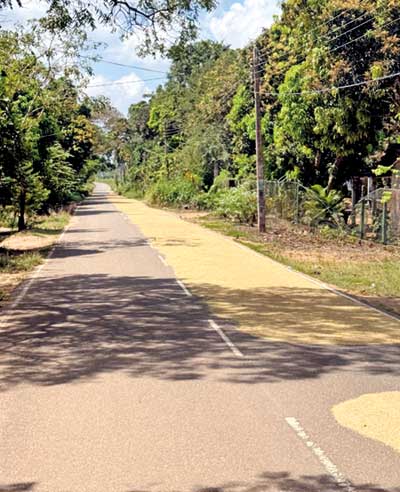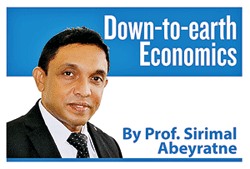Yet to start unlocking SL’s growth potential
View(s):Mass poverty

A quiet country road in Sri Lanka.
According to the latest issue of Sri Lanka’s Development Updates, released by the World Bank in April 2025, nearly a quarter of Sri Lankans survive on less than Rs. 1,000 per day, while two-thirds live on less than Rs. 2,000 daily. This paints a concerning picture of the economic hardship of crisis-driven mass poverty in the country.
The COVID-19 pandemic triggered a global economic downturn, pushing millions into poverty. However, by 2023, on average, global poverty levels had largely returned to pre-pandemic figures—but it is not so in Sri Lanka making it one of the exceptional cases. The nation endured its worst post-independence economic crisis in 2022, making recovery far more difficult than in other parts of the world.
In response, the government launched the “Aswesuma” social protection programme, which currently provides cash subsidies to around two million impoverished citizens—just under 10 per cent of the population. While cash transfers certainly help the poor survive, they are not a long-term solution for lifting people out of poverty.
This raises critical questions: where does the path to sustainable poverty reduction lie? And how prepared are we to implement lasting solutions? Should we follow the path that is revealed by the above slogan? What does the world experience in poverty reduction reveal?
Growth potential
Across the world, there are fascinating examples of successful poverty alleviation, particularly in China and India—two countries that once housed the majority of the world’s poor.
In the 1990s, China had over 800 million people living in poverty, accounting for more than 75 per cent of its population. Yet, within just 25 to 30 years, the country managed to reduce its poverty rate to a mere 1 per cent, an extraordinary achievement.
India, too, has made significant progress. In 1992, over 450 million Indians lived in extreme poverty, defined by the international poverty line of US$1.90 per day. By 2012, this number had been cut by more than half. According to the latest global benchmark of $2.15 per day, India’s poverty rate declined dramatically—from 16.2 per cent in 2011–12 to just 2.3 per cent in 2022–23.
Beyond China and India, several other Asian and African nations have also reported remarkable successes in poverty reduction over the past two to three decades. A common thread among these countries—one from which Sri Lanka can draw valuable lessons—is their ability to unlock their economic growth potential. Sustainable poverty alleviation is not merely about financial assistance but about fostering an environment where economic opportunities can thrive.
True recovery
In the recent past, Sri Lanka has been reaping the rewards of its determined and sacrificial efforts over the past three years (2022-2024) to navigate the crisis-ridden economy through fiscal consolidation and debt restructuring. However, true recovery lies in economic growth—specifically, inclusive growth, which has the potential to create jobs and generate incomes, enabling the poor to escape poverty.
Inclusive growth refers to an economic expansion where a larger share of the population can actively participate in and benefit from prosperity. Sustaining growth momentum depends on several essential factors, one of which is an export-driven economy. The success stories of poverty reduction in countries like China and India confirm that fostering conditions for export-led growth has been pivotal to their progress.
In the early 1990s, China’s exports stood at less than $100 billion. By 2021, this figure had surged to over $3 trillion, demonstrating the transformative impact of a strong export base. Likewise, India saw its exports grow from less than $20 billion in the early 1990s to $400 billion after 2021. In contrast, Sri Lanka’s exports, while showing growth, have expanded more modestly—from approximately $4 billion to $12 billion in the same period.
These comparisons underscore the importance of unlocking Sri Lanka’s export potential to drive sustainable economic recovery and poverty alleviation. A focused strategy on boosting exports could position the country for long-term, inclusive prosperity.
Export-led growth
Why exports and not import substitution? The global market offers unlimited opportunities for industries to expand, innovate, and compete. By tapping into international trade, businesses can achieve economies of scale and enhance their competitiveness through continuous innovation. As a result, income generation and job creation are not constrained by the limitations of a domestic market.
 It is well established that high-income countries foster a business environment conducive to advanced innovation. However, China stands out by surpassing many high-income nations—including Japan, France, Canada, Norway, and Australia—in global innovation rankings. This explains why China continues to dominate the global market at an accelerated pace. India, too, has significantly improved its position in the Global Innovation Index, whereas Sri Lanka remains among the lower-ranked nations, positioned 89th out of 133 countries.
It is well established that high-income countries foster a business environment conducive to advanced innovation. However, China stands out by surpassing many high-income nations—including Japan, France, Canada, Norway, and Australia—in global innovation rankings. This explains why China continues to dominate the global market at an accelerated pace. India, too, has significantly improved its position in the Global Innovation Index, whereas Sri Lanka remains among the lower-ranked nations, positioned 89th out of 133 countries.
By contrast, import substitution, though politically popular and appealing to nationalist sentiments, is restricted by the limited size of the domestic market. Even in the world’s largest economies, such as China and India, the domestic market alone is insufficient for large-scale industrial expansion.
Thus, these nations rely on global market integration rather than domestic consumption alone to drive growth. For Sri Lanka, embracing an export-oriented strategy is crucial to unlocking its economic potential and achieving sustainable, long-term prosperity.
Private investment
When countries achieve economic growth through export expansion, their production structures tend to develop a strong tradable bias alongside a manufacturing bias—both essential components of sustained high growth. A tradable bias in production means that a country primarily focuses on producing goods and services that can be traded internationally, fostering competitiveness and market integration.
However, some countries, including Sri Lanka, have disproportionately emphasised the expansion of non-tradable sectors such as construction, infrastructure, telecommunications, government services, and public administration. While these sectors contribute to overall economic development, they have minimal direct impact on export growth. Consequently, growth driven by non-tradable sectors is inherently limited unless these industries play a supportive role in facilitating export expansion.
Another key characteristic of tradable bias is its reliance on private investment, particularly Foreign Direct Investment (FDI). In Sri Lanka’s case, foreign investment has primarily been credit-financed public investment or government-to-government foreign investment, largely allocated toward infrastructure development. Meanwhile, foreign private investment remains at minimal levels, restricting the country’s ability to fully leverage international trade opportunities and sustain long-term economic growth.
For Sri Lanka to unlock its full economic potential, fostering an export-driven, private investment-oriented growth model is imperative. Strengthening policies that encourage foreign private investment and enhancing competitiveness in global markets will be crucial steps toward long-term prosperity.
Manufacturing and urban bias
When economic growth is driven more by private investment than public investment, it tends to be accompanied by manufacturing expansion. As a result, fast-growing economies experience shifts in both output and employment structures. The contribution of manufacturing value addition to GDP begins to rise more rapidly than that of agriculture.
Consequently, workers employed in agriculture start transitioning to non-agricultural sectors, eventually leaving less than 5 per cent of the labour force in agriculture as countries become wealthier. However, in Sri Lanka, it is striking that over a quarter of the labour force remains engaged in agriculture, making it a less productive and less rewarding sector.
Traditional agriculture is often characterised by surplus labour, allowing export-led industrial growth to absorb excess labour from rural areas. This shift in the employment structure ultimately yields net positive outcomes for the economy.
Urban-rural divide
The expansion of urban-based industries drives labour migration from rural agriculture to urban centres, making ‘urban bias’ in economic growth inevitable. This transition fosters urbanisation, necessitating the development of basic services and suitable living environments for migrating populations.
While labour migration from rural to urban sectors is typically a natural outcome of evolving production structures, China has actively promoted and planned this transition through government initiatives. Its 10-year New Type Urbanisation Plan, launched in 2014, aims to relocate 100 million people from rural areas to urban centres, ensuring employment opportunities and improved urban living conditions.
Moreover, the urban bias in production creates favourable conditions for rural agriculture to evolve into a ‘large-scale’ and ‘more innovative’ sector. Unlike traditional agriculture, modernised farming practices—driven by technological advancements and innovation—enable greater competitiveness in both quality and price in global markets.
Resolving poverty
Sustainable poverty reduction in Sri Lanka over the coming years hinges on generating income and creating employment opportunities. Achieving this is a medium- to long-term process that requires Sri Lanka to proactively pursue the path of growth and structural transformation. I am not sure if we have started it yet.
Global growth experiences have shown that unlocking a country’s economic potential is typically driven by an export bias, tradable bias, manufacturing bias, private investment bias, and urban bias. However, these changes cannot be realised solely through policies that promote structural transformation and economic expansion. For, equally important are regulatory reforms aimed at removing bottlenecks that hinder such progress.
(The writer is Emeritus Professor at the University of Colombo and Executive Director of the Centre for Poverty Analysis (CEPA) and can be reached at sirimal@econ.cmb.ac.lk and follow on Twitter @SirimalAshoka).
Hitad.lk has you covered with quality used or brand new cars for sale that are budget friendly yet reliable! Now is the time to sell your old ride for something more attractive to today's modern automotive market demands. Browse through our selection of affordable options now on Hitad.lk before deciding on what will work best for you!


